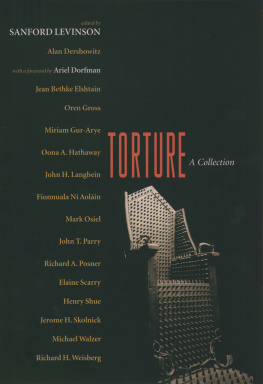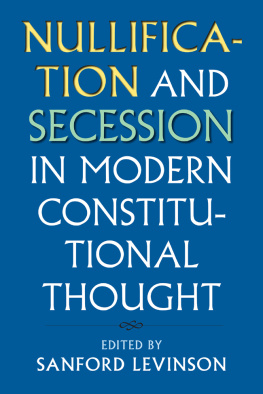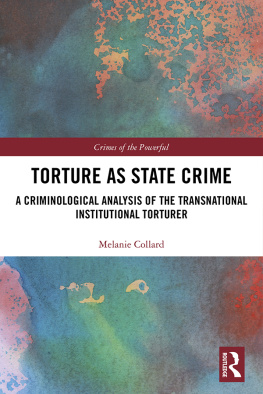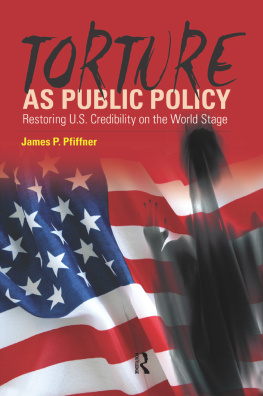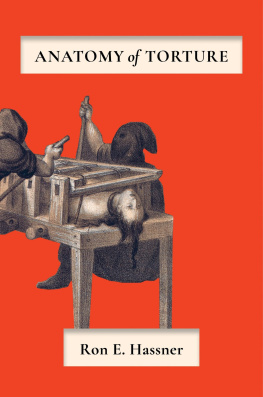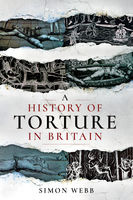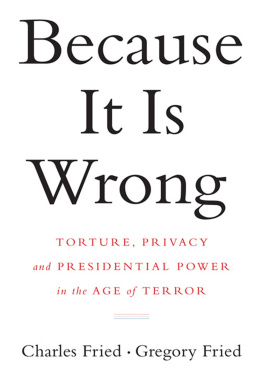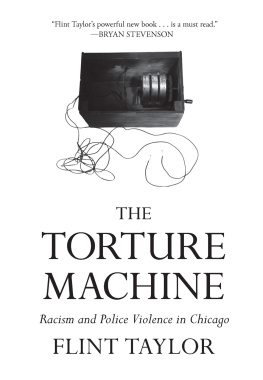TORTURE
This depiction of a suspect being tortured comes from a series of engravings appended to the official text of the Austrian Empires Criminal Procedure Code of 1769, called the Constitutio Criminalis Theresiana. The engravings, which illustrate various means for inflicting torture in the courts of Prague and Vienna, were intended as guides for local craftsmen and court functionaries in constructing and operating such devices. This plate shows a flaming torch being applied to the chest of an accused who is being racked.
TORTURE A Collection
EDITED BY
SANFORD
LEVINSON


2004

Oxford New York
Auckland Bangkok Buenos Aires Cape Town Chennai
Dar es Salaam Delhi Hong Kong Istanbul Karachi Kolkata
Kuala Lumpur Madrid Melbourne Mexico City Mumbai Nairobi
So Paulo Shanghai Taipei Tokyo Toronto
Copyright 2004 by Oxford University Press, Inc.
, Torture by Henry Shue, appears courtesy of Philosophy and Public Affairs Blackwell Publishing. All rights reserved.
, Political Action: The Problem of Dirty Hands by Michael Walzer, appears courtesy of Philosophy and Public Affairs Blackwell Publishing. All rights reserved.
Published by Oxford University Press, Inc.,
198 Madison Avenue, New York, New York 10016
www.oup.com
Oxford is a registered trademark of Oxford University Press.
All rights reserved. No part of this publication may be reproduced, stored in a retrieval system, or transmitted, in any form or by any means, electronic, mechanical, photocopying, recording, or otherwise, without the prior permission of Oxford University Press.
Library of Congress Cataloging-in-Publication Data
Torture : a collection / edited by Sanford Levinson.
p. cm.
ISBN 0-19-517289-2
1. TortureMoral and ethical aspects. 2. Human rights. 3. Political prisonersLegal status, laws, etc. I. Levinson, Sanford, 1941
HV8593.T662 2004
323.49dc22 2004008860
CONTENTS
FOREWORD
The Tyranny of Terror: Is Torture Inevitable in Our Century and Beyond? |
Part_I
Philosophical Considerations |
Part_II
Torture as Practiced |
Part_III
Contemporary Attempts to Abolish Torture through Law |
Part_IV
Reflections on the PostSeptember 11 Debate about Legalizing Torture |
TORTURE
FOREWORD
The Tyranny of Terror
A bit over twenty-five years ago, history forced me to write a poem that, perhaps as a way of accentuating the horror I felt, came to be called Hope.
My son has been
missing
since May 8th
of last year.
They took him
just for a few hours
they said
just for some routine
questioning.
After the car left,
the car with no license plate,
we couldnt
find out
anything else
about him.
But now things have changed.
We heard from a compaero
who just got out
that five months later
they were torturing him
in Villa Grimaldi
at the end of September
they were questioning him
in the red house
that once belonged to the Grimaldis.
They say they recognized
his voice his screams
they say.
Somebody tell me frankly
what times are these
what kind of world
what country?
What Im asking is
how can it be
that a fathers
joy
a mothers
joy
is knowing
that they
that they are still
torturing our son?
Which means
that he was alive
five months later
and our greatest
hope
will be to find out
next year
that theyre still torturing him
eight months later
and he may might could
still be alive.
It is sadand more than sad, it is tragicto remark that the questions asked in that poem, written over a quarter of a century ago and dealing with the horror spilling out of the Pinochet dictatorship, continue to haunt us today. We can all unfortunately repeat those words from a distressed parent, a father, perhaps a mother, unable to recognize what the world has become; can we not echo them all over again? Somebody tell me frankly, what times are these? What kind of world? What country?
Here is the transitory answer. More than twenty-five years after that poem was written, we live in a world where torture is practiced on a regular basis in more countries than ever132 at the latest count, but who knows if there are not moreand where torture is being contemplated as inevitable and even beneficial in nations that call themselves democratic and respectful of the rights of their citizens. More than twenty-five years after that poem was written, I live in a countrythe United Stateswhere a leading civil rights lawyer has suggested that the courts might issue torture warrants as a way of fighting terrorism. We live in times where people, in this land and in so many other supposedly civilized nations, are so filled with primal fear that they look on with apparent indifference at the possibility of extreme maltreatment of their presumable enemiesindifference, indeed, at the evidence and televised images of this sort of maltreatment. We live in times where it is no longer abhorrent to express the need to apply electricity to the genitals of a prisoner or tear out his fingernails or keep him for days on end in a cage and blindfolded, if that will save our skin, protect our children, foster our security. The times, the country we live in, allow torture to be applied, as it always has been, in our name, by allies and socalled friends and partners.
It is also true that we live in a world where there have been some startling advances in the last twenty-five years in the struggle to abolish torture from the face of the earth and, perhaps more essentially, from the basements of humankind. Implicit in those questionswhat times are these? what kind of world? what country?was the belief that such a situation could not, should not, be normal, would someday not be normal. The queries themselves expressed the hidden desire that we would all someday find unfamiliar and absolutely strange this degrading procedure and the suffering it created, not only for the victims but for those who surrounded and survived them. Behind the questions, within the questions, there was indeed the hope that a time would dawn when such terror and absurdity would no longer seem customary or everyday, that this sort of pain inflicted by one man on a defenseless other would not even be possible to conceive. The questions contained the perverse expectation, therefore, then as now, that a day would come when we will be unable to even pose themnot pose them at alla day when humanity lives up to the best image of itself reflected in the mirror of the future.
If that expectation has not been fully met, and torture is as pervasive and persistent as ever, we should nevertheless be careful not to ignore some of the very significant steps taken to free the world of this plague in the latter part of the twentieth century, starting with the extraordinary organizational progress among the forces opposed to torture and human rights abuses. Over the years, a resilient army of citizens, victims, and lawyers who research, denounce, lobby, and campaign has made its appearance, growing into a transnational network of activists and concerned men and women that has been very effective in holding governments and individuals accountable for these kinds of abuse. Paramount perhaps in the growth of this movement has been the self-organization of the torture survivors themselvesthe Torture Abolition and Survivors Support Coalition (TASSC) is itself a splendid example and modelaccompanied by the creation of a number of medical centers dedicated to healing the psychological and physical wounds left by torture. Because this sort of profanation of the body and the mind is precisely meant to render the victims passive, mute, depressed, and ashamed; to destroy their dignity and exclude them from society; and to make them afraid for the rest of their lives, there can be nothing more encouraging than the efforts of those very victims to work actively on behalf of others who have suffered the same fate to stop that fate from devouring others.

